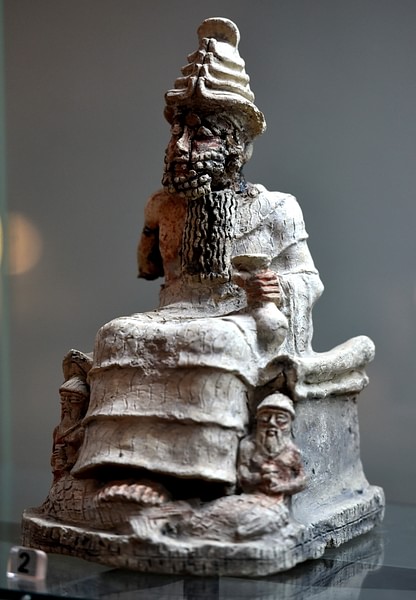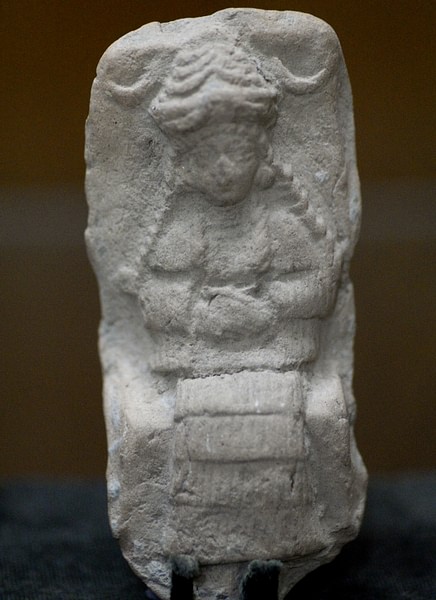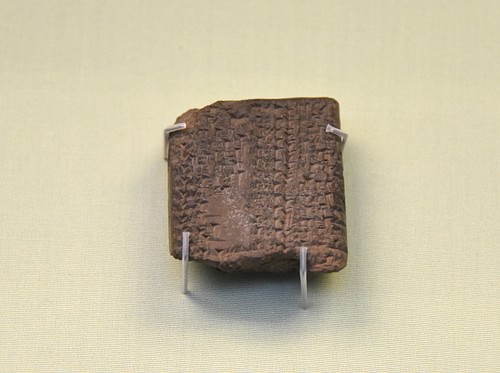
Tiamat is the Mesopotamian goddess associated with primordial chaos and the salt sea best known from the Babylonian epic Enuma Elish. In all versions of the myth, following the original, Tiamat always symbolizes the forces of chaos, which threaten the order established by the gods, and Marduk (or Ashur in Assyrian versions) is the hero who preserves it.
She is depicted, in later periods, as a female serpent or dragon based on vague descriptions of her in Enuma Elish, but no iconography exists from ancient Mesopotamia. Her name, according to scholar Jeremy Black, comes from the word tiamtum meaning “sea” (Gods, Demons, and Symbols, 177). Although her name is referenced in a much earlier Akkadian inscription, she does not figure in extant Mesopotamian mythological literature until Enuma Elish, written under the reign of the Babylonian king Hammurabi (1792-1750 BCE) and usually dated to c. 1750 BCE but no doubt written earlier. Later mentions of the goddess are simply copies and variations of this work.
It has been suggested that Tiamat is the Babylonian version of the Sumerian Mother Goddess Nammu (also given as Namma) but there are significant differences between the two deities, notably that Nammu is consistently a nurturing, caring figure while Tiamat is vengeful and tempestuous. In Enuma Elish, she is defeated by the hero-god Marduk and some scholars, such as Paul Kriwaczek, interpret the poem as a “codified” history of the rise of the male chieftain (known as the Lugal = Big Man) in Mesopotamian society.
Other scholars (such as Robert Graves) have seen the work as a poetic response to the loss in status of female deities during Hammurabi's reign when male gods – notably Marduk – superseded them, arguing that the poem is an artistic representation of the rise of a patriarchal religious paradigm over an earlier matriarchal model.
It is more likely, however, that neither of these interpretations is correct or, at least, they do not fully address Tiamat's character or the central focus of Enuma Elish. Both interpretations ignore the history of the time the poem was written and fail to fully address the character of Tiamat and how the author of Enuma Elish draws on the earlier Sumerian goddesses, Nammu and Inanna, to create the goddess of chaos.
Nammu, Inanna, & Tiamat
Nammu is first attested during the Early Dynastic Period in Mesopotamia (2900-2334 BCE), specifically the period known as Dynastic III (2600-2334 BCE), although she most likely existed in oral form before that. Nammu is described as the “original mother who gave birth to the gods” in the Sumerian poem Enki and Ninmah, but this work has not been definitively dated. Jeremy Black comments:
Lack of anything but a fairly general historical framework for Sumerian compositions means that any chronological approach to literary questions, such as the development of genres or correlation with historical processes or events, must be largely abandoned. (Reading Sumerian Poetry, 23)
In Enki and Ninmah, the goddess Ninmah (better known as Ninhursag) and god of wisdom Enki create human beings as helpers for the younger gods who are tired of manual labor and the maintenance of order against the forces of chaos. When the poem begins, the younger gods have been crying out to Enki to help them but he continues to sleep and does not hear until he is awakened by his mother Nammu who carries the gods' tears to him and influences him to help.
Unlike Nammu, Inanna was never a Mother Goddess. Inanna was the Sumerian goddess of fertility, love, procreation, and sensuality but was also associated with war, violence, and capriciousness. She was originally a minor vegetative deity who grew so popular that she came to be worshipped throughout Mesopotamia as the Queen of Heaven and is featured in a number of well-known Mesopotamian myths as well as in The Epic of Gilgamesh (written c. 2150-1400 BCE) under her later incarnation as Ishtar.
![Offering to Inanna, Warka Vase [Top Register]](https://www.worldhistory.org/img/r/p/500x600/10591.jpg?v=1724658839-1724658887)
Tiamat has been claimed to be the Babylonian version of Nammu but there is hardly any scholarly consensus on this claim. The only similarity between the two is that both are female, associated with the sea, and feature in stories concerning the creation of the world and humanity. Some scholars have noted that neither goddess had a cult following or temple dedicated to them but this claim has been challenged by the mention of a shrine to Nammu in Babylon.
The most significant difference between the two is their intrinsic nature: Nammu is a nurturer while Tiamat's initial impulse toward caring for others is blunted by her seeming betrayal by her children and, afterwards, she becomes vengeful and destructive. This latter aspect of Tiamat associates her closely with Inanna who, especially in The Epic of Gilgamesh as Ishtar, does not take rejection well and is prone to a violent response.
Enuma Elish Summary
The Enuma Elish begins with the creation of the universe, originally an undifferentiated mass of water swirling in chaos. The waters divided into fresh and salt and the freshwater formed the god Apsu while the saltwater the goddess Tiamat; from their union were born the younger gods. At first, all was well, but the younger gods became increasingly loud and boisterous, upsetting their parents:
The divine brothers came together
Their clamor got loud, throwing Tiamat into a turmoil.
They jarred the nerves of Tiamat
And by their dancing they spread alarm… (lines 21-24)
Tiamat is upset with them but feels powerless to influence their behavior:
Tiamat was silent when confronted with them.
Their conduct was displeasing to her,
Yet though their behavior was not good, she wished to spare them. (lines 26-28)
Apsu is also irritated by his children's actions and confers with his vizier Mummu about the problem. They agree nothing can be done until they have spoken with Tiamat and so they go to her chamber where Apsu opens the discussion, saying:
“Their behavior has become displeasing to me
And I cannot rest in the day-time or sleep at night.
I will destroy and break up their way of life
That silence may reign and we may sleep.”
When Tiamat heard this
She raged and cried out to her spouse,
She cried in distress, fuming within herself,
She grieved over the plotted evil [saying]
“How can we destroy what we have given birth to?
Though their behavior causes distress, let us tighten discipline graciously.”
(lines 37-46)
Mummu interjects at this point, encouraging Apsu to destroy his children, and Tiamat's plea is ignored. Apsu and Mummu agree to kill the younger gods and Tiamat, not knowing what else to do, feels she must warn her children. She goes to the god of wisdom Ea (also known as Enki) and tells him about the plot.
Ea, in addition to his great wisdom and intellect, was also god of magic. He puts Apsu to sleep through an incantation and kills him and then imprisons Mummu. Apsu becomes the freshwater of Ea's home (associated with the Sumerian city of Eridu elsewhere) and, once everything is settled and Ea has established order, he and his wife Damkina live happily and she gives birth to their son Marduk.
Marduk is more powerful than any of the other gods, described as “dazzling” and “mighty” with “the aura of the Ten Gods, so exalted was his strength” (line 103). The Enuma Elish lavishes the greatest praise on the young god before stating how he became an even bigger nuisance to Tiamat than her children were before:
He formed dust and set a hurricane to drive it.
He made a wave to bring consternation on Tiamat.
Tiamat was confounded; day and night she was frantic. (lines 107-109)
The elder gods, also her children, confront her about the death of their father, reminding her that, when Apsu was killed she did nothing and when Mummu was imprisoned she did not make any complaint. Now, they tell her, Marduk and the other younger gods make all their lives miserable by doing as they please without any consideration for their elders.
They scold her that she does not love them and beg her to make war on the younger gods, avenge Apsu, and put an end to the constant noise and aggravation. Tiamat listens to their counsel and agrees to go to war, saying, “Let us make demons, as you have advised” (line 126). She then gives birth to the eleven monsters, known as Tiamat's Creatures, who will help her fight against the younger gods:
- Musmahhu, Usumgallu, Basmu – three horned snakes, Furious, Exalted, and Venomous
- Umu-dabrutu – a raging storm
- Mushussu – a snake-dragon
- Lahamu – a hairy beast-man
- Ugallu – a lion-demon
- Uridimmu – a lion-human hybrid
- Girtablullu – a scorpion-man
- Kulullu – a fish-man (merman)
- Kusarikku – a bull-man
She then chooses the god Quingu, her lover, to lead her forces as champion and gives him the Tablets of Destiny, which legitimize a god's rule and control the fates; whoever holds the Tablets of Destiny has supreme power over the heavens, earth, and underworld. With her formidable army, Tiamat goes to war against her younger children and defeats – but does not kill – them. The younger gods struggle against overwhelming power but cannot stand against Quingu and the Tablets of Destiny or the eleven creatures of Tiamat, who lead the other gods against them.
The younger gods fall into despair but Marduk volunteers to go and fight Tiamat and her legions alone on the condition that, afterwards, he is to be made supreme ruler:
“If I should become your avenger,
If I should bind Tiamat and preserve you,
Convene an assembly and proclaim for me an exalted destiny.
Sit, all of you…in gladness,And let me, with my utterance, decree destinies instead of you.
Whatever I instigate must not be changed.
Nor may my command be nullified or altered.” (lines 156-162)
The younger gods gladly agree and give him a magical mace and club while he fashions a mighty bow himself and calls down lighting to assist him. He then meets Tiamat in battle, swiftly defeats Quingu, and takes the Tablets of Destiny. He kills Tiamat by smashing her skull with his mace and then splitting her in two with one of his arrows. He then kills Tiamat's creatures and has the other gods bind them to his feet as trophies. From Tiamat's corpse, he creates the heavens and the earth and from her weeping eyes flow the Tigris and Euphrates rivers; her tail becomes the Milky Way.

Commentary & Interpretation
Tiamat, as a literary/mythological character, is routinely interpreted as symbolizing the chaos which existed before the establishment of order in the universe, yet the poem itself does not exactly support this claim. Tiamat is against the use of violence at the beginning of the poem and begs her husband to try less drastic measures. It is only after Apsu is murdered by Ea, and she accepts the counsel of her older children, that she – feeling betrayed and rejected by the younger gods – instigates the war against them. She is certainly a chaotic force afterwards but cannot be seen as such at the beginning of the poem.
Her change from protective, nurturing mother to vengeful warrior-queen has been claimed to be due to a shift in the theological paradigm in Mesopotamia during the reign of Hammurabi during which female deities (and women in general) lost their status. This interpretation was first suggested by the British scholar Robert Graves and later popularized by historians such as Merlin Stone in the bestselling book When God Was a Woman.
The argument claims that Tiamat combines the earlier qualities of Nammu as a Mother Goddess with the later association of female deities as troublesome and vindictive, as in the case of Inanna who becomes the erratic and violent Ishtar by the time of The Epic of Gilgamesh, flies into a fury when Gilgamesh rejects her advances and causes the death of the Bull of Heaven and Gilgamesh's friend Enkidu. Graves, and others, claim that the shift from a matriarchal to a patriarchal theological vision is poetically addressed in the figure of Tiamat in Enuma Elish because it could not be overtly stated in any other form.
There is no doubt that the worship of female deities declined during Hammurabi's reign and formerly powerful goddesses were replaced by gods. The problem with Graves' interpretation is that there is no evidence of there ever having been a “matriarchal theological paradigm” in Mesopotamia. The earliest Sumerian inscriptions concerning the gods, while they do mention many feminine deities, always have a dominant male presiding over the Mesopotamian pantheon.

When news came that brigands were on their way, spotted perhaps by herdsmen tending their animals out in the wild far from the city walls, the call would go out for men to mount resistance. Farmers turned themselves into a citizen militia, dropping their spades and hoes, and picking up clubs and spears. Yet while this may have been an adequate defensive response to small bands, it was insufficient to repulse a battalion-sized incursion. For that, a trained body of semi-professional fighters was needed and, eventually, a fully professional army. The older power-centers of Sumerian society, the temple priesthood and assemblies of elders, would have been able neither to muster the appropriate number of men nor to lead them into battle. That task would have fallen by default to the new economic elite…the “big men” …with their great estates and retinues of followers. (87)
The elevation of the “Big Man” – the chieftain – according to Kriwaczek, is at the heart of the Enuma Elish as Marduk becomes the undisputed king of the gods after demanding that as a condition of defeating the forces of chaos. In this same way, a chieftain would protect a community from threats in return for their loyalty and service. Tiamat, in this interpretation, serves simply as a threat to established order and Marduk stands as the heroic champion who not only preserves order but improves upon it; just as a local chieftain, and later a king, was expected to do.
Conclusion
Kriwaczek's interpretation, however, ignores the careful construction of Tiamat's character at the beginning of the poem and her close association with Nammu. It also fails to address why Enuma Elish was so popular, why it was read annually at Marduk's festival on the New Year, and why it came to be integral to that festival even after Hammurabi's death. One could claim that Tiamat's characterization is due to the lingering concept of the Mother Goddess, specifically Nammu, and, like Graves, argue that the author is purposefully highlighting the old paradigm in order to later twist and subvert it and, in keeping with this, that the popularity of the piece, and its importance to Marduk's festival, was a celebration of the triumph of the patriarchy. Again, this interpretation can only hold if one can establish that there was an earlier matriarchal paradigm to subvert.
It could be, however, that the author of Enuma Elish was not attempting to subvert any paradigm nor write an allegory of the rise of tribal chiefs and kings but was only creating the work he had been commissioned to write by Hammurabi. Marduk was a minor agricultural god in the region before Hammurabi came to power but was the deity the king chose as his own patron god. Prior to Hammurabi's reign, as noted, Inanna was the patron goddess of Babylon and, though she continued to be venerated afterwards, her status was greatly diminished after the king elevated Marduk to Babylon's patron deity.
In the figure of Tiamat, the author combines the characteristics of Nammu the Mother Goddess with Inanna - two well-known goddesses in Mesopotamian mythology - to show how their earlier authority has given way to that of Marduk, son of Enki/Ea but under no one's influence. The work, then, and the figures of Tiamat and Marduk, would not be a subversion of any widely-held paradigm nor an allegory of the rise of the ruling class, but simply the announcement of a new powerful god, the end of the need for any others, and the glorification of the king this great god so clearly favored.






